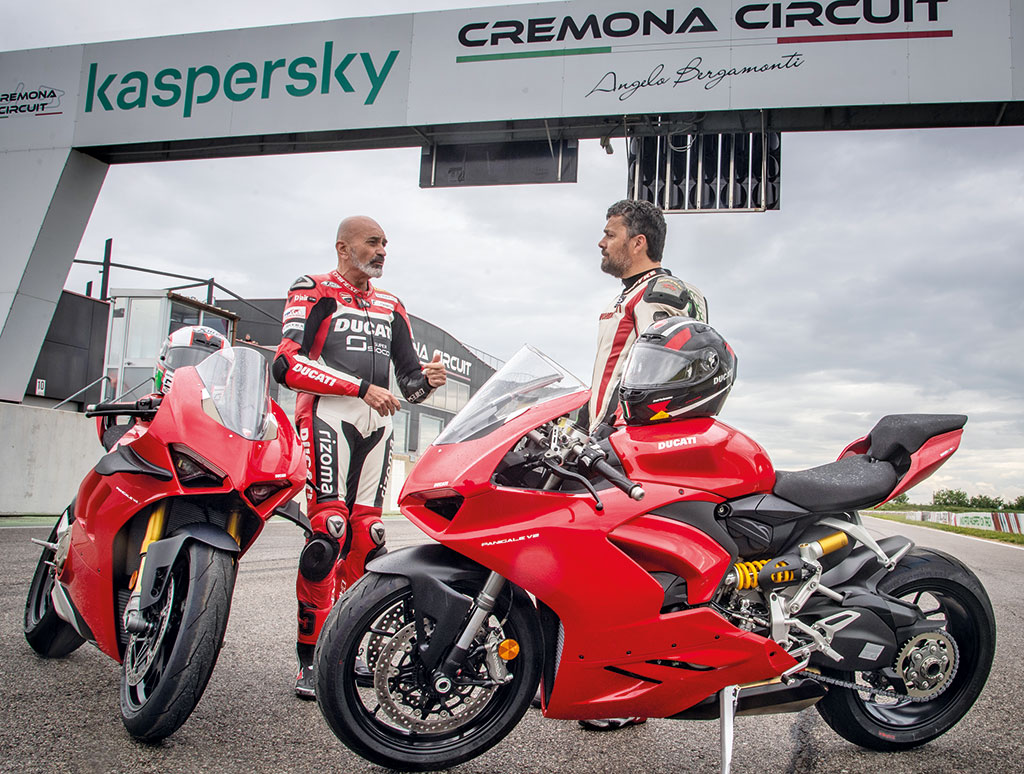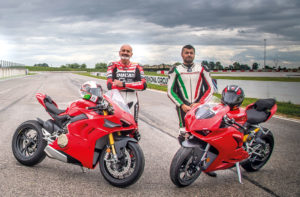“Du gust is megl che uan”. But are four cylinders better than two? In front of the most bad and performing among the Ducati the question comes spontaneously, but the answer depends on you. What a biker you are.
Both the Panigale V4 S and the Panigale V2 fall into the category of supersports, but they have very different souls, for this reason Borgo Panigale has kept both in production and last October even presented the new versions.
Since the smanettoni are not all the same, it becomes interesting to compare them, to understand which one models on one another as a dress of high tailoring and which a little less.
Ducati Corse’s intervention on the Panigale V4
I think I’ve driven all versions of both from birth to today, yet every time I’m surprised at the advances in electronics. There’s so much more, but it’s the one that set the pace for everything else.
Remember the old Pirelli advertisement? “Power is nothing without control.“
On the Panigale V4 S the jump was great: it is the evolution of last year’s model and was developed in collaboration with Ducati Corse, in particular with the engineer Carlo Ricci Maccarini of the Superbike development team.
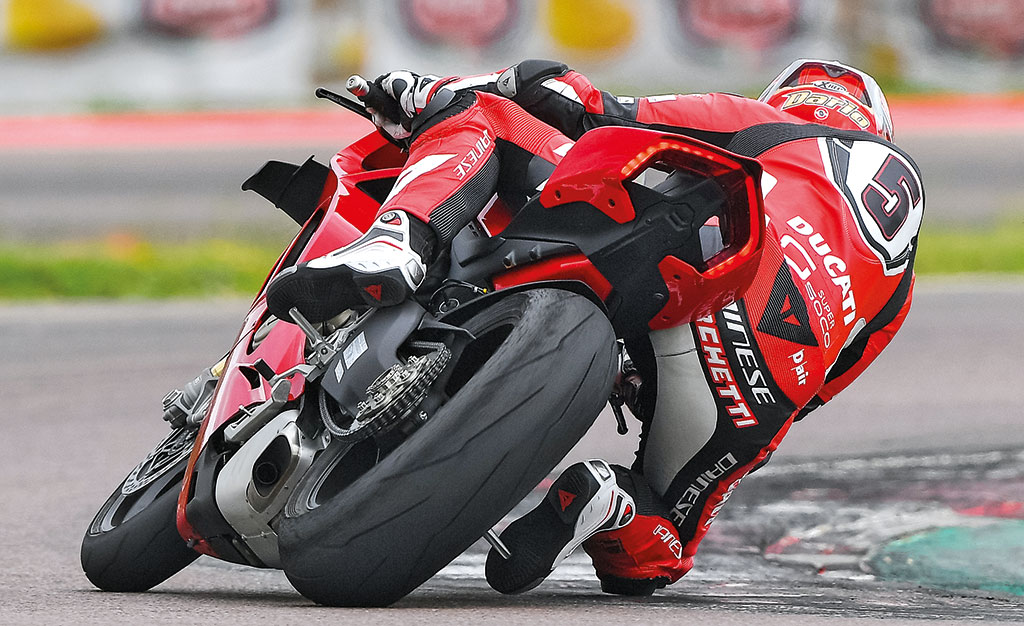
Many solutions that were already on the V4 Rlast year, the 1000 approved for THE SBK, have been passed on to this one that was born the year before and that is 1100 and cannot access the “traditional” races.
In particular, electronics are not exactly the same, because there are different needs, but the strategies are similar.
Do we want to start with Traction Control? It was 8 levels even before, but when it came into action it “stopped you”; the EVO2 is definitely more performing,you keep making your way and you can leave black commas on the asphalt while maintaining excellent control.
The beauty is that there was no step back in safety, but “only” one ahead in performance, a particularly marked difference in the freest maps.
Other mappings have also changed, such as that of the Ride-by-wire which now gives a more progressive gas response, whereas before it was a bit abrupt, especially in “Race” mode. It means greater confidence and, given the horses available, this is not at all unpleasant!
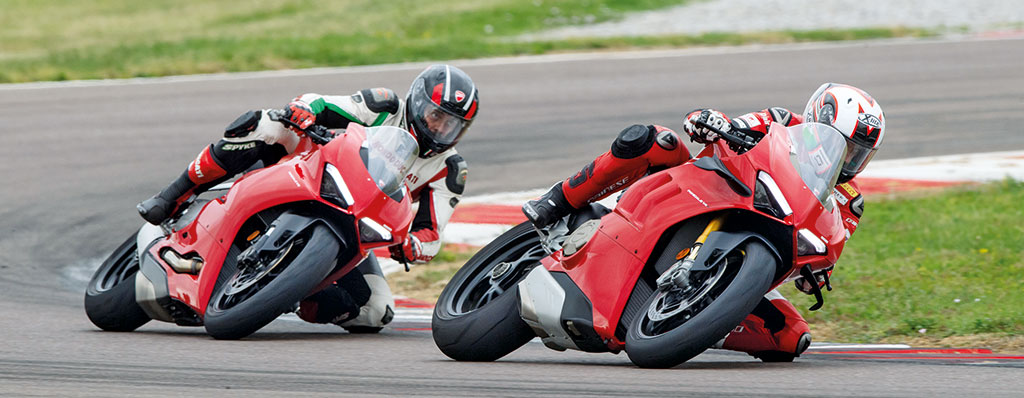
The chassis is now the same as the R. To be more precise, since the Panigale V4 has the carrier engine and not a real chassis, what is called the “Front Frame” has changed, that is, the front frame that incorporates the steering cannotto; is less rigid and gives an even greater feeling on the front, so the bike is more intuitive.
Another intervention that has brought significant advantages is the different placement of the swingarm’s fork.
Unlike the R, where the position of the fulcrum is adjustable, here it is fixed; it has been moved high to achieve an increase in grip in acceleration,due to the effect on the chain shot that crushes the bike the most.
In addition, the tendency to soar is reduced, favored by the action of a very effective Anti Wheeling.
Panigale V4 S: where’s the trick?
It is surprising to find such a tractored bike, despite the fact that in standard configuration it reaches 214 horsepower at 13,000 rpm and can go up to 226 Hp by mounting the Akrapovic exhaust of the Performance kit.
But I’ll tell you the trick: just take some power off when it’s appropriate. With electronics, Ricci Maccarini softened the dispensing in the first three reports. It reverses the gas and it almost seems that the bike pushes little, the reality is that it does not put in difficulty: the peaks of power and torque that made it aggressive have been cut.
The reduction is progressive, greater in the first, minor in the second and even less in the third; from the fourth onwards the bike is free and pushes hard.
So, despite the speedometer going up very fast, it seems to have a sweet engine even in race mapping, the most extreme. This, together with the frame with different geometries, the semi-active Öhlins suspension, the higher trim and the new pivot position, conveys a feeling of safety and precision.
The V4 S 2020 is a tiger, but tame, easy to use when the other, under certain conditions, was more aggressive.
Among the evolutions that are particularly appreciated is the fairing with wings,also inherited from the Panigale R: the new aerodynamics has allowed to obtain 30 kg more load on the front at 270 per hour, which result in excellent stability at high speeds.
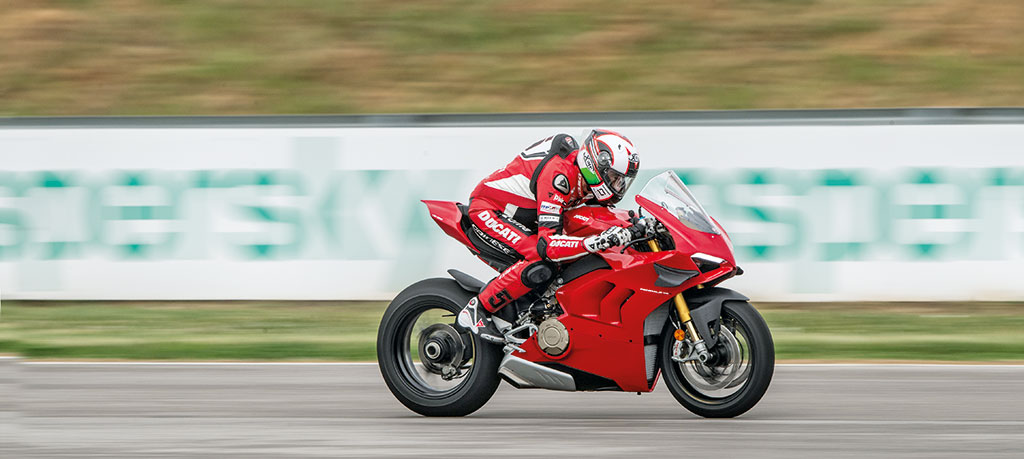
Yet the bike does not lose in handling, indeed it is very agile. As was said earlier, much has changed compared to the previous version. It’s an omoron, but it’s the reality: it’s stronger nowand yet it doesn’t put you in crisis , because being more human is also easier to push to the limit.
Panigale V4 S: for many, but not for everyone
The facts speak: Ducati has carried out comparative tests right on the Cremona circuit, the same as this test.
As a result, an inenourished rider, moving from the previous version of the V4 S to the current one, is 3″ faster on the lap, while a fierce amateur improves by 1″9 – 2″2 on the lap; Michele Pirro, who is a professional rider, earns 1.5 per lap.
Paradoxically, the higher the level and the lower the benefit, because the new bike goes stronger and the improvement is still there, but a sailed rider could also take advantage of the previous one despite the fact that it given less help, while a little experienced one could be put in difficulty.
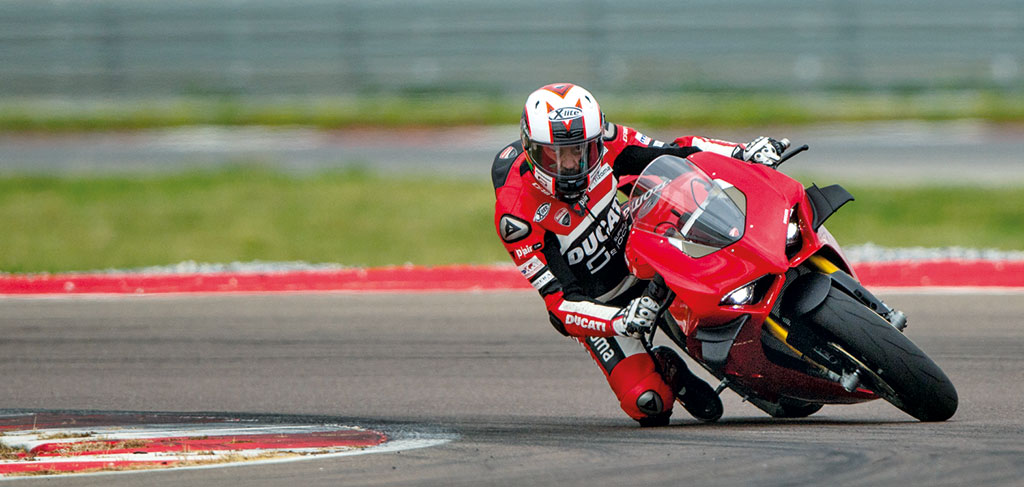
Be careful not to overdo it with confidence though: if after this chat you are starting to take measurements at V4 S, at least in theory, keep in mind that it has a very precise and very intuitive guide, and since it is agile not tired, but still requires a certain job.
It’s been made easier to drive, but there are still over 200 horses to manage: when you want to go really hard it becomes challenging, and if it is true that with riding modes you can adapt it at will, it is equally true
Panigale V2: the other side of the test
On the other side of the ring, the Panigale V2,a challenger who despite the lower power is better not to underestimate.
If he were a boxer we would say that it is smaller, but beats hard: it is the maximum expression of the twin-cylinder, 155 horsepower at 10,750 rpm and a vigorous torque of 104 Nm at 9000 rpm, with practically the same electronics as the V4 S.
In this latest version, like the four-cylinder, it has cornering ABS which is a nice safety.
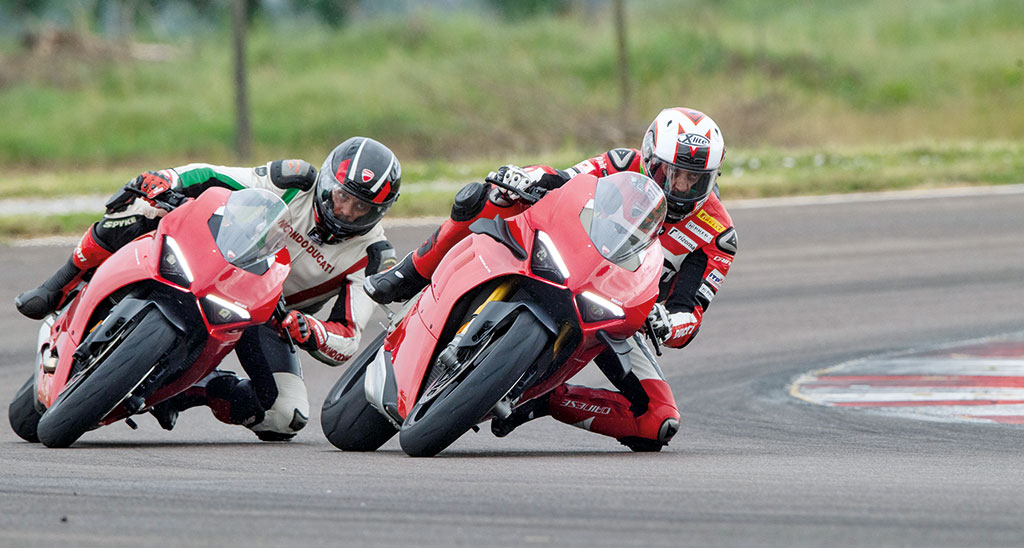
Previously the ABS only worked with straight motion, now even if the claps run away during the descent into the crease, the steering does not close; simply the bike tends to get up and widens the trajectory, but does not throw you into the ground. The pumping sensation on the lever is also very contained.
In any case, braking, as well as in the V4 S, is a reference: both are powerful and modular,the feeling is of safety and precision.
Another novelty of the latest edition twin-cylinder is the introduction of the blipper,or if you prefer quickshifter up/down, that is, the electronic gearbox that also works in climbing. On the previous 959 there was only to climb, and to climb it was necessary to use the clutch, now it is like in racing bikes and the clutch only serves to start.
Ducati Panigale V2: easy to love
Getting on the Panigale V2 is a very pleasant dive into the past, because the supply of the twin-cylinder engine is unique: it is nice to feel the vigorous torque, the powerful shot enhances.
The comparison with the V4 leaves the time it finds because it is a comparison between two different worlds. This has a nice “back”, that is, a robust thrust that starts from the bottom and continues to pump hard even when you get to the top; However, it does not arrive at the same regimes as the other and it is not advisable to seek the extension, but rather to exploit its vigorous pair, sometimes even anticipating change.
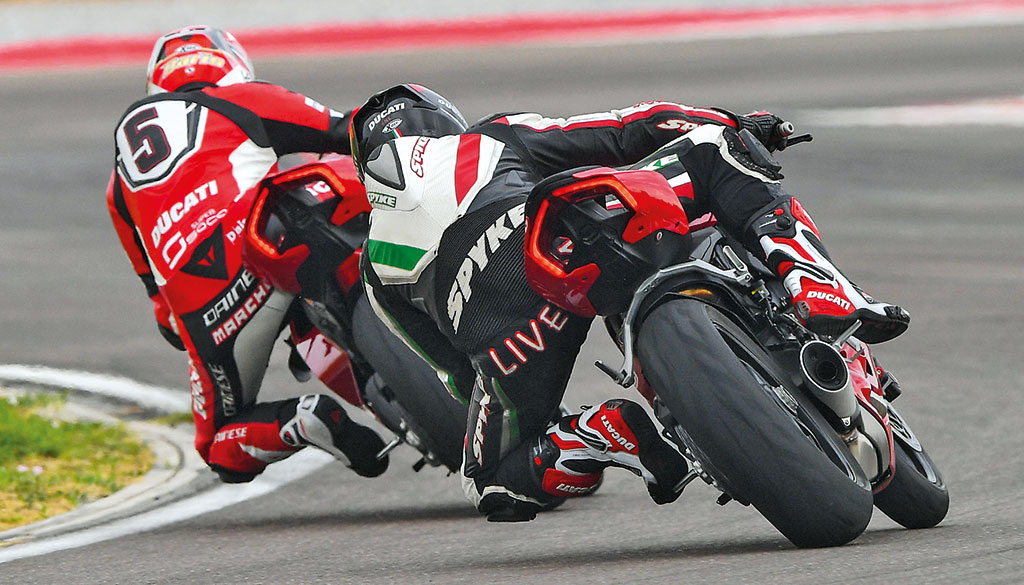
If you really want to make a comparison, the V4 S is a super technological bike,of the future, while this is the extreme development of a motorcycle of traditional conception. But very, very evolved.
I think about it when I drive it: with the exhaust of the Performance kit, which here too is an Akrapovic, you set up suspension, you put two good tires and on the track it allows you to sell your skin dearly against motorcycles that have much higher powers.
I checked it once more during this test, shooting together with Gian Maria Liverani and making comparisons.
In the strait the V2 is a bad customer, it is very agile and has a great guide; it is more accessible than the four cylinders because it is less powerful, what’s more it costs almost 11,000 euros less,17,990 against 28,790. That’s not a detail either!
The V4 S is the top, it is good for the smanettone who wants to experience the same emotions as a MotoGP or a Superbike; the V2 also gives satisfaction to those who are not as stormy, butwant to have fun anyway. In addition, the new electronics have made it safer: between Cornering ABS and Traction Control to fall you have to make resounding mistakes.
The V4 S is a bomb, it has the Twin Pulse engine and at low speeds it seems to drive a twin-cylinder, but at highs it pushes endlessly, it has exceptional dispensing characteristics; but the V2 in the strait is a hard bone.
Handling and shooting are the same skills that a few years ago allowed the twin cylinder to fight on par with the four cylinders in the Superbike World Championship. It is a fun and undemanding bike, it has a lower limit than the other and paradoxically this is precisely its value, because it allows you to push it close to the maximum even to those who are not a rider and with the other perhaps would not be able to have fun.
Forget the character of the old 1098 and 1199,the electronics make this V2 very easy. Without the ride-by-wire you had 130 horses and you felt like you had 200; this one has 155, from the curves pushes out with vigour, yet it does not put in difficulty.
Of course, the V2’s favorite terrain is the strait. In the Cremona circuit there is a 970-meter straight in which the V4 S can discharge all the power and there is no history there, but the fault lies with the four cylinders which is monstrous!
Panigale suspensions in comparison: computers and screwdriver
Also in the analysis of the suspensions emerges the different soul of our two bikes.
The V4 has the second-generation electronic Öhlins which are a spectacle: setting the set up before leaving you can choose whether to have them “free“, i.e. with a configuration that remainsfixed,or ” progressive “. In this second “mode” the system adapts the calibration in real time: in braking hardens the fork to give you support; loosen the brake, bend down and soften it, because it has to absorb roughness and make the front give more feeling; accelerate and the fork hardens again.
On the twin-cylinder, on the other hand, the suspension is traditional and everything is less technological, to the satisfaction of those who want to “just” ride a motorcycle, without too many complications.
They are efficient, but if you want a different calibration you have to intervene in a traditional way, with the screwdriver, changing the spring preload, modifying the hydraulic brake and everything else.
When you go on the track there is work to be done a little more with your hands, but this to the generation that was born without the computer is not scary!
The conclusion is the one you read at the beginning of the article: the V4 S and V2 are part of the same category, that of supersports, but they are very different.
Both allow you to take off some nice satisfactions, but it is all depending on the rider and the route. So there is a question that remains suspended in the air:‘Which one would you buy?’
Who, me?
Both!
Photohouse Photo
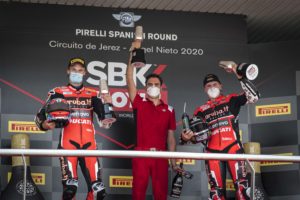
SBK a Jerez: avanti tutta!
A Jerez de la Frontera, seconda tappa del campionato SBK, si ri-accende lo spettacolo con Ducati protagonista. Doppietta di Redding e secondo posto in gara 2 per Davies.
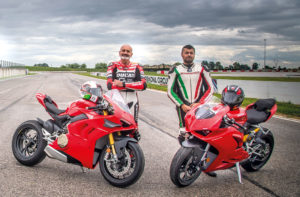
Panigale V4 S e V2: confronto 2 – 2020
Il confronto tra le Ducati Panigale V4 S e la Panigale V2, due moto diverse e con personalità distinte, secondo Gian Maria Liverani.

